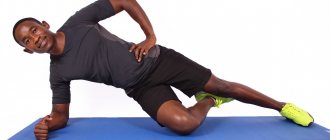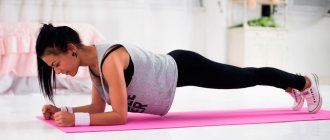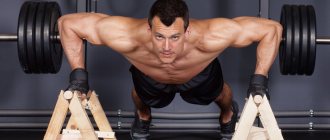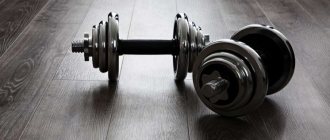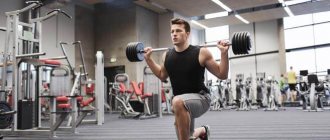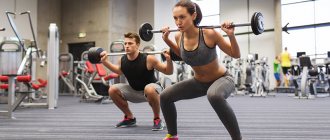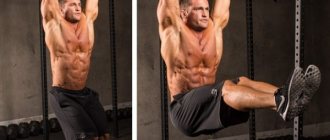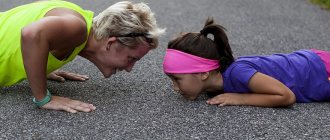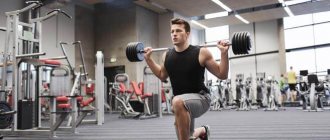Setting a goal
To create a home workout plan for the week, you need to decide on your goals. A person must understand whether he needs to increase muscle size or lose weight, then set a realistic and achievable goal. Once excessive demands are made, motivation for further studies disappears. Finding out your goal plays a huge role in developing your weekly home workout plan. Based on the data, the frequency of task completion, the number of repetitions and the structure of the training are determined. To get results, you must adhere to the established training regimen at home for 12 weeks.
Exercises with dumbbells for men at home
By adding exercises with dumbbells for men to your training program, you can significantly speed up your progress at home. Let's get acquainted with the most effective exercises for home workouts:
| Squats with dumbbells . Performed like classic squats, but with additional weight. The body must be held vertically and seated as deep as possible. |
| Lunges with dumbbells . Familiar lunges, but with dumbbells. This exercise allows you to load all the muscles of your legs. While performing the exercise, keep your back as straight as possible. |
| The dumbbell bench press is an exercise that pumps up the chest muscles. When lowering the dumbbells, your elbows should be spread to the sides, stretching the pectoral muscles as much as possible. |
| Lying dumbbell flyes are an isolating exercise that exclusively targets the pectoral muscles. You need to be careful when lifting dumbbells. You should not try to lower the projectile too low, otherwise you can injure your shoulder joints. |
| The seated dumbbell press is the best exercise for shoulder development. Involves the anterior and middle heads of the deltoid muscles. |
| Standing dumbbell swings . Another exercise that develops the deltoid muscles. Starting position - legs slightly bent at the knees, body leaning forward slightly. Throughout the entire approach, you cannot raise your elbows above shoulder level, so the load goes to the trapezius, and our goal is to work on the shoulders. |
| Bent over dumbbell rows are great for pumping up your back muscles. You need to perform it smoothly, without sudden movements. We keep our back perfectly straight, otherwise we will get injured. |
| Alternating dumbbell bicep curls in a standing position are an exercise for working the biceps. It is in no way inferior to the version with a barbell, and in some ways even superior. |
| Hammers with dumbbells - an exercise for biceps, performed in a standing position, without jerking or swinging. |
| Extension of arms with a dumbbell from behind the head . An excellent exercise for pumping up huge triceps. You can perform the exercise sitting or standing, keeping your back straight. |
What equipment will you need?
Many training plans are designed to be carried out in training centers. Physical activity involves the use of special weights and exercise equipment, which are not always available at home. To stretch the shoulder area, you will need dumbbells; they can be purchased at sports stores or replaced with plastic bottles filled with liquid. To strengthen the upper body, parallel bars or a bar are suitable.
A weekly home workout plan for flexibility involves the use of the following sports accessories:
- expander;
- fitball;
- rubber loops.
Selection of exercises
How to make a workout plan for a week at home correctly? First of all, choose the appropriate exercises. They are divided into 2 categories:
- To work out a muscle group;
- Working with your own body weight or weights.
It is advisable to focus the training complex on the muscles of the whole body.
Top part
To stretch the upper block, use weights and an expander. Trainers recommend performing the following exercises:
- on shoulders. Push-ups and dumbbell lifts, rubber band stretching;
- on the chest. Bend forward, raise your arms while lying on your stomach, gluteal bridge, warm up your back;
- on the biceps. Concentrated lifts, expander rows and weight lifting;
- for triceps. Various types of push-ups and dumbbell extensions.
Stomach
You should include abdominal exercises in your weekly home workout plan. First of all, to stretch the rectus muscle:
- twisting;
- bar;
- scissors;
- bicycle in a recumbent position;
- superman;
- climber.
Then the lateral muscles are engaged and leg lifts are performed in a side-lying position, a bridge and a side plank.
Buttocks and lower limbs
The following types of physical activity are suitable for a soft spot:
- lunges;
- deadlift;
- all kinds of squats;
- bridge.
To make it more difficult, an expander is included in the work.
The posterior femoral surface is warmed up by bending or abducting the lower limbs, squats and lunges to the side and back and forth. Walking and running on your toes will be beneficial for your calves.
Cardio loads
Your weekly home workout plan should include cardio. The following tasks are suitable:
- jumping rope;
- exercise bike;
- regular jogging.
Interval training gives a good effect. It requires extreme concentration and performance while performing intense and short exercises.
Among others, it is worth highlighting Tabata. This is high-intensity training with short rest intervals. The technique consists of 20 seconds of physical activity, then a pause of 10 seconds. Perform 8 approaches. Over the course of 1 hour, 3 to 4 types of exercises alternate.
How to choose the right exercises?
If you have decided on your goal and the capabilities that home workout accessories provide you, it's time to choose the appropriate exercises. Divide the exercises into two categories - exercises for the muscle group you want to work and exercises with your own weight or with weights . Your comprehensive training plan should target the muscles of the entire body, so keep the following exercises in mind: [2] [3] [8] [10] [11]
Upper body
During these exercises in the gym, kettlebells, dumbbells, and an upper or lower pulley are used. For home workouts, you can also use dumbbells or water bottles, and the resistance band will replace the upper or lower block.
Shoulder exercises – seated dumbbell press, front dumbbell raise, dumbbell lateral raise, expander raise, chin row with expander
Chest exercises – incline dumbbell press, incline dumbbell fly, chest fly, dumbbell bench press, push-ups, scissors exercise
Back exercises – gluteal bridge, candle exercise, superman exercise, sitting back exercise, arm raise while lying on your stomach, deep forward bend
Biceps exercises – dumbbell biceps curl, expander row for biceps, concentrated biceps curl
Triceps exercises – close-grip push-ups, dumbbell triceps extensions, reverse push-ups, diamond push-ups
Press
Exercises for the rectus abdominis muscle – plank, Russian twist, crunches, mountain climber, scissors, prone bike, superman exercise
Exercises for the lateral abdominal muscles – bridge, side leg raise, side plank [9]
Buttocks and legs
Glute exercises - squats, lunges, deadlifts, glute bridges, lying leg curls, sumo squats, Bulgarian squats, jump squats - all exercises can be made more difficult with an expander.
Exercises for the back of the thigh - lying leg curls, bridges, leg extensions with an expander, lunges, squats, side lunges
Calf exercises – standing calf raises, walking and running on your toes
At the same time, do not forget about cardio training . You can use an exercise bike, go for a run , or jump rope. An excellent alternative is also HIIT training - high-intensity interval training . This workout requires maximum performance and concentration during short but intense exercises. In 20 minutes you can burn up to 270 calories , strengthening your entire body. Tabata is also a high-intensity workout with short breaks. Each interval takes about 4 minutes, but it will probably be the longest 4 minutes of your life. The structure of such a workout is as follows: intense exercise for 20 seconds, 10-second pause, 8 approaches . During one hour of Tabata, 3 to 4 exercises alternate, for a total of 24-32 approaches. [6] [7]
Training frequency
A home workout plan involves alternating sports activity with rest breaks. During physical activity, small cracks form in muscle cells. Their recovery takes from 24 to 48 hours and is determined by the intensity of exercise. Experienced athletes recommend doing strength training 3-4 times a day. in Week. It is advisable to select exercises to include different muscle groups.
Cardio training increases your heart rate, so you should not overdo it. The optimal cardio rate is from 3 to 4 r. in Week. The best option is to alternate strength tasks with cardio training. It is advisable for beginning athletes not to bother themselves and take more days off.
Home workout programs
Let's divide the training plan into two options - cardio and strength, which you can quite successfully implement at the same time if your goal is to both lose weight and build muscle.
Strength training at home
You need to exercise 3-4 times a week.
Always perform 1 warm-up set with a light weight, a warm-up set with a medium weight, and then begin using the working weight. As we said earlier, you need to perform 5 to 8 repetitions on average.
For strength training at home, you need to purchase: several pairs of dumbbells and weights of different weights. This is a minimum set that will allow you to use more exercises, since in some cases it is quite difficult to find a replacement for them at home. A weighted vest and a short bar with a set of 5 and 10 kg weight plates are very suitable. But this is already possible.
Day 1 – chest/shoulders/biceps
- classic push-ups - 1-2 sets of 10-12 times
- dumbbell bench press – 8x5
- dumbbell flyes – 12x4
- Wide grip chin pull - 8x4
- biceps curls - 15x4
Day 2 – back / triceps
- close grip push-ups - 8-10 times 5 sets
- deadlift with dumbbells – 5–7x4
- standing bent-over row with reverse grip - 8x4
- One-arm bent-over row - 6x4
Day 3 – legs/abs
- classic squats with dumbbells – 8–10x5
- squats with wide legs – 8–10x5
- lunges with dumbbells – 8–10x5
- full crunches - 15–18x5
In order for strength training to be successful, that is, your strength is constantly growing, you need to increase the weight of the equipment. Doing this at home is very problematic, so keep in mind that if your goal is to “grow” significantly, then you need to work out in the gym. If you are satisfied with the relief and slight muscle growth, then you can achieve this at home.
The right start
To obtain the desired results and to prevent injury, a warm-up must be included in your home workout plan. She helps:
- restore joints and muscles;
- reduce tension and pain in muscles;
- minimize injuries;
- improve athletic fitness;
- increase the flexibility of the body and mobility of all its members.
If desired, they can play sports using online broadcasts. Such trainings are conducted by experienced professionals. The proposed instructions will help novice athletes master the correct technique for performing sports tasks.
When the scheme is changed
The workout schedule at home has to be changed periodically. This is required so that all muscle groups are included in the work, and a noticeable result appears. Trainers are advised to maintain the basic structure of the training process, but periodically change the number of repetitions and exercise variations. The optimal period for changing the training plan is 3 months.
Beginners can extend this time. Because it is important for them to learn the correct technique for doing the exercises. The training scheme is changed in the following cases:
- to increase the intensity of classes;
- when adding new tasks;
- increase the number of repetitions if desired.
The main challenge in doing home workouts is to tailor your physical activity plan to your fitness goals. And if you combine proper nutrition with sports activities, you can get stunning results in a month.
Exercises for home workouts with your own weight
There are many bodyweight exercises for men; below are the most effective ones for creating a training program:
| Pull-ups are one of the most effective basic exercises to train at home and strengthen your back muscles. You can perform pull-ups with different grips. By experimenting with grips, you can put stress on different muscle groups. | |
| Wide grip pull-ups . The palms are located slightly wider than the shoulders. The exercise is performed smoothly, you need to try to feel the latissimus muscles, because they bear the maximum load. | |
| Close grip pull-ups . Jump onto the horizontal bar so that your hands touch each other. By performing pull-ups in this way, the load shifts to the bottom of the latissimus muscles and biceps. | |
| Reverse grip pull-ups . When doing pull-ups in this version, the biceps take the lion's share of the load. When performing the exercise, be collected and try to feel your biceps in each repetition. | |
| Push-ups are a basic exercise in training for beginners at home to pump up the pectoral muscles and triceps muscles of the arms. The number of repetitions is approximately 80% of the maximum. | |
| Push-ups with wide arms . The exercise is performed to work the pectoral muscles. To make it more difficult, use palm rests to increase the range of motion. Try to push up as deeply as possible, stretching your pectoral muscles as much as possible. | |
| Push-ups with elbows tucked in engage all three heads of the triceps. The exercise is performed at full amplitude and at an average pace. | |
| Reverse push-ups . To perform this you need a bench or chair. When performing the exercise, you should not slouch and allow your elbows to diverge to the sides, otherwise the triceps will not receive the proper load. | |
| Dips can be called the big brother of push-ups. Only dips are much more difficult than push-ups. The number of repetitions depends on the physical capabilities of the athlete. Athletes who have difficulty doing push-ups may not even look towards the bars. | |
| Bodyweight squats work the muscles in your legs and buttocks. To weigh it down, use improvised means, for example, a backpack or water bottles. For those who find it easy even with weights, you can squat on one leg. |
| Lunges are another exercise for pumping up your legs. When performing lunges, the main thing is to keep your body perpendicular to the floor. The exercise affects all leg muscles: quadriceps, buttocks and hamstrings. |
| Raising your legs while hanging on a horizontal bar loads your abdominal muscles better than other exercises. The lion's share of the load is taken by the lower abs. |
| Forward crunches are a classic exercise for pumping up your abdominal muscles. Mostly the upper abdomen receives the load. The main thing when doing crunches is not to lift your lower back off the floor, otherwise you can get injured. |
Read also: Push-up program
